During my years traveling through the Peruvian jungle, I have been fascinated by the animals in the Peruvian Amazon and have realized that it is one of the most biodiverse ecosystems in South America. So, is Peru a megadiverse country?
Yes, it is! Its lands are home to more than 400 species of mammals, 1,800 species of birds, 2,500 species of fish, and around 15,000 species of plants. Of course, I can’t mention them all, but in this blog, I want to invite you to discover other fascinating species that you may not know about and that you may encounter on your next trip to this region.
So today, I bring you a complete list of 35 animals from the Peruvian jungle that, if you’re lucky, you may encounter during your adventure. Join me to learn more about each of them and discover some recommendations for your encounter with wildlife.
You might be interested: 15 Traditional food in Peru
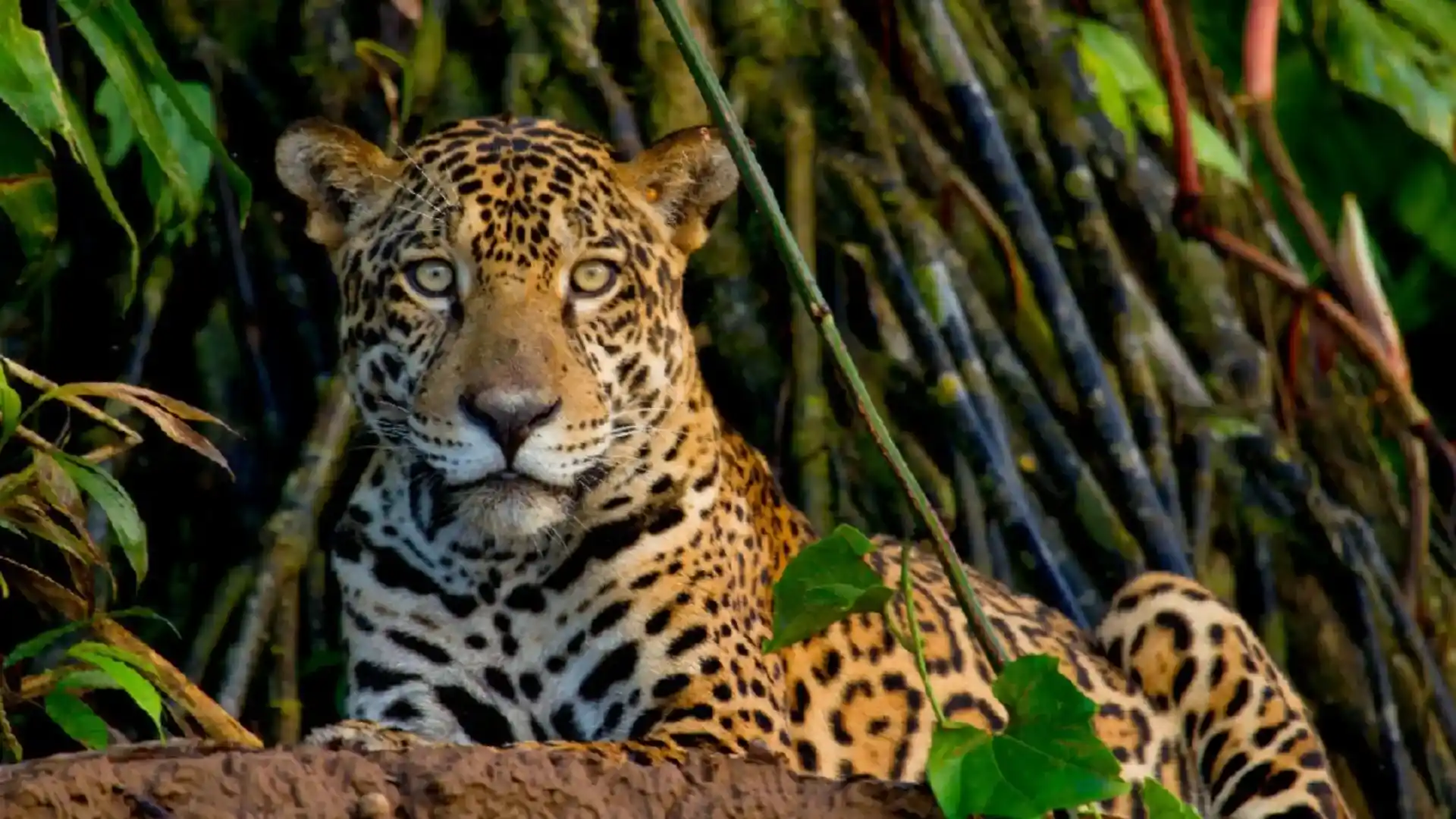
Amazon rainforest mammals
The Peruvian Amazon rainforest is home to an astonishing variety of mammals, most of which you won’t be able to see anywhere else in the world. To start with Animals in the Peruvian Amazon, I want to start with the most popular mammals, but don’t just think about monkeys or jaguars. There are extraordinary aquatic species that have adapted to the wildest ecosystem in the region.
1. Jaguar
The jaguar is the largest cat in South America and lives mainly in regions such as Madre de Dios, Ucayali, and Amazonas. This solitary and territorial predator is found in areas of dense vegetation and near rivers, where it can hunt with ease. With its golden coat and black spots, the jaguar is the mammal most eagerly sought after by tourists. The Tambopata Research Center, the only lodge in the Tambopata Reserve in the Peruvian Amazon, boasts a 35% chance of seeing a jaguar in its natural habitat.
2. Pink river dolphin
The pink dolphin, one of the most fascinating animals in the Peruvian Amazon, is a true spectacle of nature. It is found in rivers such as the Amazon, Ucayali, and Marañón, where it swims with agility through the murky waters of the jungle. The most curious thing about this dolphin is its color: as it ages, its skin becomes pinker, giving it a unique appearance. These dolphins are known for their intelligence, playful behavior, and ability to jump and perform acrobatics, making them one of the most adorable and amazing animals in the Amazon that you will surely want to see. Without a doubt, an encounter with the pink dolphin is one of the most magical experiences in the jungle!
3. Howler monkey
You can recognize the howler monkey by its distinctive howl, which can be heard up to 5 kilometers away in the Peruvian jungle. It is mainly found in the trees of the lowland rainforest, feeding on leaves and fruit. But don’t be afraid if you come face to face with one, as these animals are peaceful and spend most of the day resting in the trees.
You might be interested: World tourism day in Peru 2025
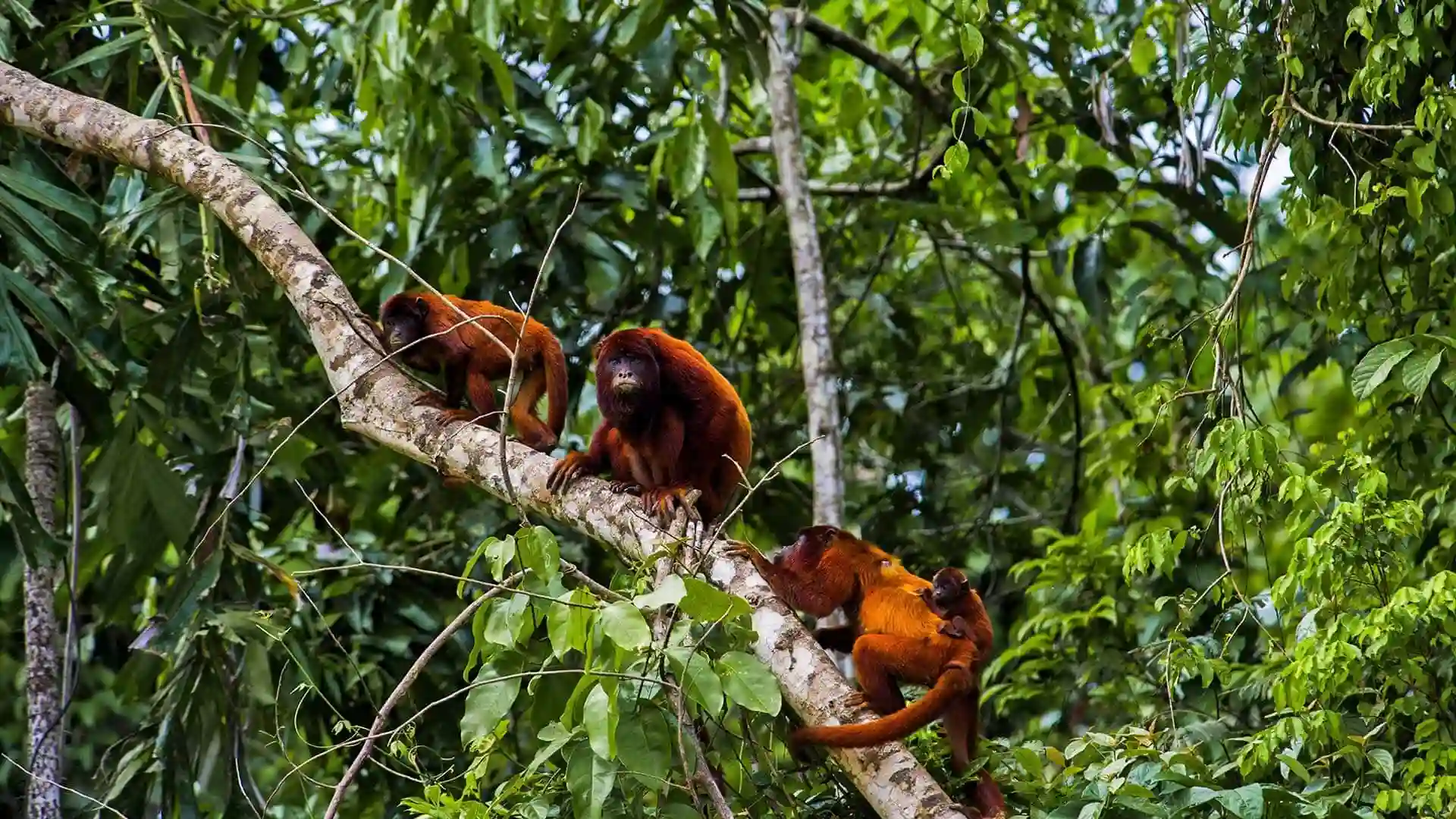
4. Amazonian tapir
The Amazonian tapir is one of the largest mammals, but it is a shy animal, and if you happen to see one, consider yourself lucky. It inhabits areas near rivers and rainforests, where it feeds mainly on fruits, leaves, and twigs. Despite its slow gait, the tapir is an exceptional swimmer and dives effortlessly into the waters of the Amazon, so you may see it if you take a canoe trip.
6. Nine-banded armadillo
The nine-banded armadillo, known in Peru as Carachupa, is a small mammal notable for its armor of bony plates. Its size varies, but it generally measures between 40 and 60 cm in length, including its tail. This curious animal lives mainly in dry jungle areas and forests of the Peruvian Amazon, where it feeds on insects, larvae, and small vertebrates.
5. Giant river otter
The giant river otter can measure between 1.5 and 1.8 meters and is one of the most impressive aquatic mammals in the Peruvian Amazon. It lives in family groups along rivers, lakes, and swamps and is known for its social behavior and incredible ability to swim and fish. But when you walk along the rivers, you can see it playing, always with its family.
You might be interested: Visiting Peru in September: Complete Guide
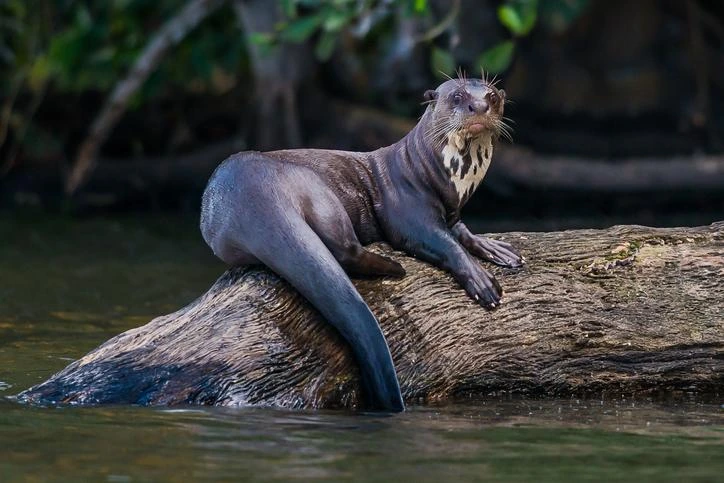
7. Collared anteater
The collared anteater, or Tamandua, is known for its distinctive yellow fur on its chest that forms a “collar.” This anteater is smaller than its cousin, the giant anteater, and is found in the tropical rainforest of Peru, especially in the Amazon region.
8. Capybara
The capybara is the largest rodent in the world, measuring up to 1.3 meters and weighing 50 kg, but this peaceful rodent inhabits the banks of rivers, lakes, and wetlands in the Peruvian Amazon rainforest. The capybara is known for its relaxed behavior, and many travelers enjoy observing its interaction with other jungle animals during their trips along the riverbanks.
9. Sloth
The sloth, known for its characteristic slow pace of life, inhabits the trees of the Peruvian Amazon rainforest. But did you know that there are two types? In Peru, there is the three-toed sloth and the two-toed sloth. Sloths spend up to 20 hours a day sleeping, which gives them their characteristic calmness. You can see them on your next visit to the Madre de Dios rainforest and other areas of the Amazon.
You might be interested: Festivals in Cusco month by month
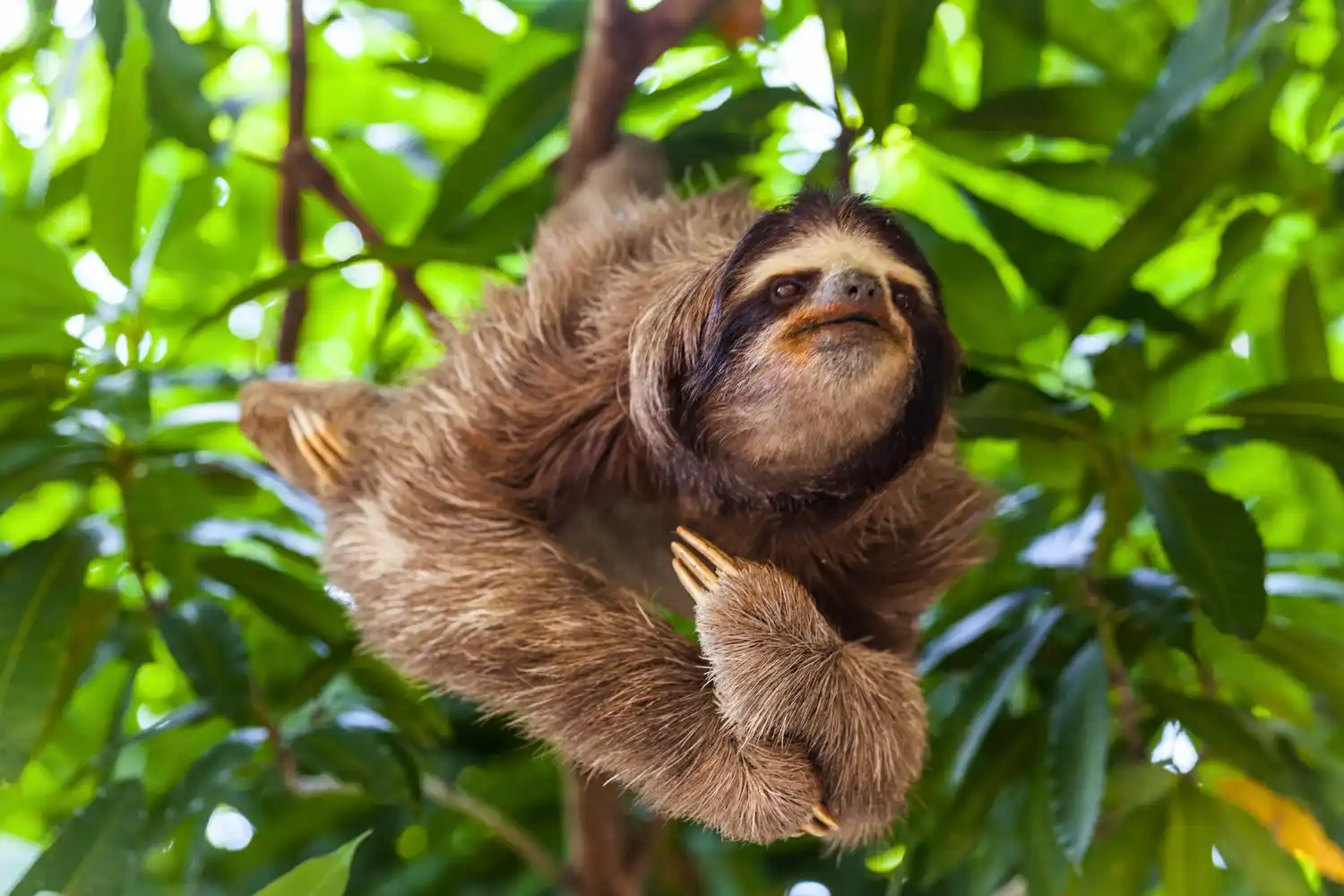
Amazon rainforest birds
The Peruvian Amazon rainforest is a paradise for birdwatchers, and you can observe everything from the majestic macaw to the mysterious night owl. The animals in the Peruvian Amazon display a fascinating variety of birds as diverse in color as the number of feathers they flaunt, each with its own unique characteristics. In this section, we invite you to fly alongside these amazing creatures, discovering some of the most iconic birds that inhabit this corner of the world.
10. Macaw
Macaws, known for their impressive colorful plumage, mainly inhabit the Madre de Dios and Ucayali regions of the Peruvian Amazon rainforest. They can be seen in tropical forests and near rivers. Did you know that they are known for their intelligence and ability to mimic sounds? They are also one of the most emblematic birds of the Amazonian fauna.
11. Toucan
The toucan, famous for its long, colorful beak, is found mainly in the jungle regions of northeastern Peru, especially in the rainforests of the Amazon. It lives in tall trees and feeds on fruits, insects, and small reptiles. Its beak is not only a distinctive feature, but also very light, allowing it to move nimbly among the branches.
You might be interested: 7 National Parks in the Amazon
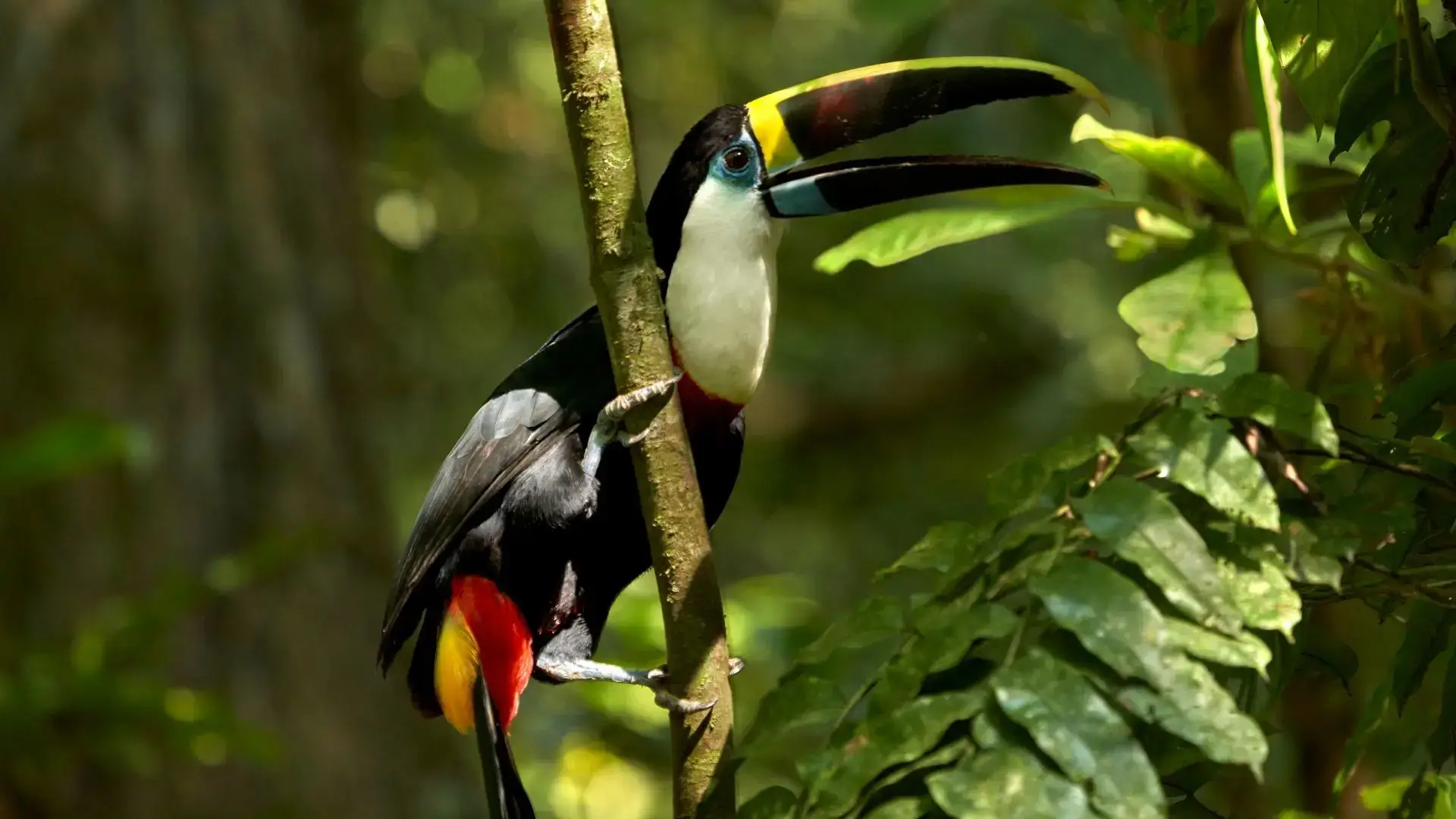
12. Harpy Eagle
The harpy eagle is one of the most powerful birds of prey in the world and is found in the jungles of Madre de Dios and other Amazonian areas. This large, emblematic species hunts monkeys, sloths, and other small mammals. With its enormous talons and impressive flight, it is known as one of the most fearsome predators in the Amazon.
13. Red-breasted Cacique
This vibrant bird is found mainly in the tropical and humid forests of eastern Peru, particularly in Madre de Dios. Its yellow and red plumage makes it easy to identify. In addition to its beauty, its melodious song is a notable feature of this cacique. I hope you get to see its live concert!
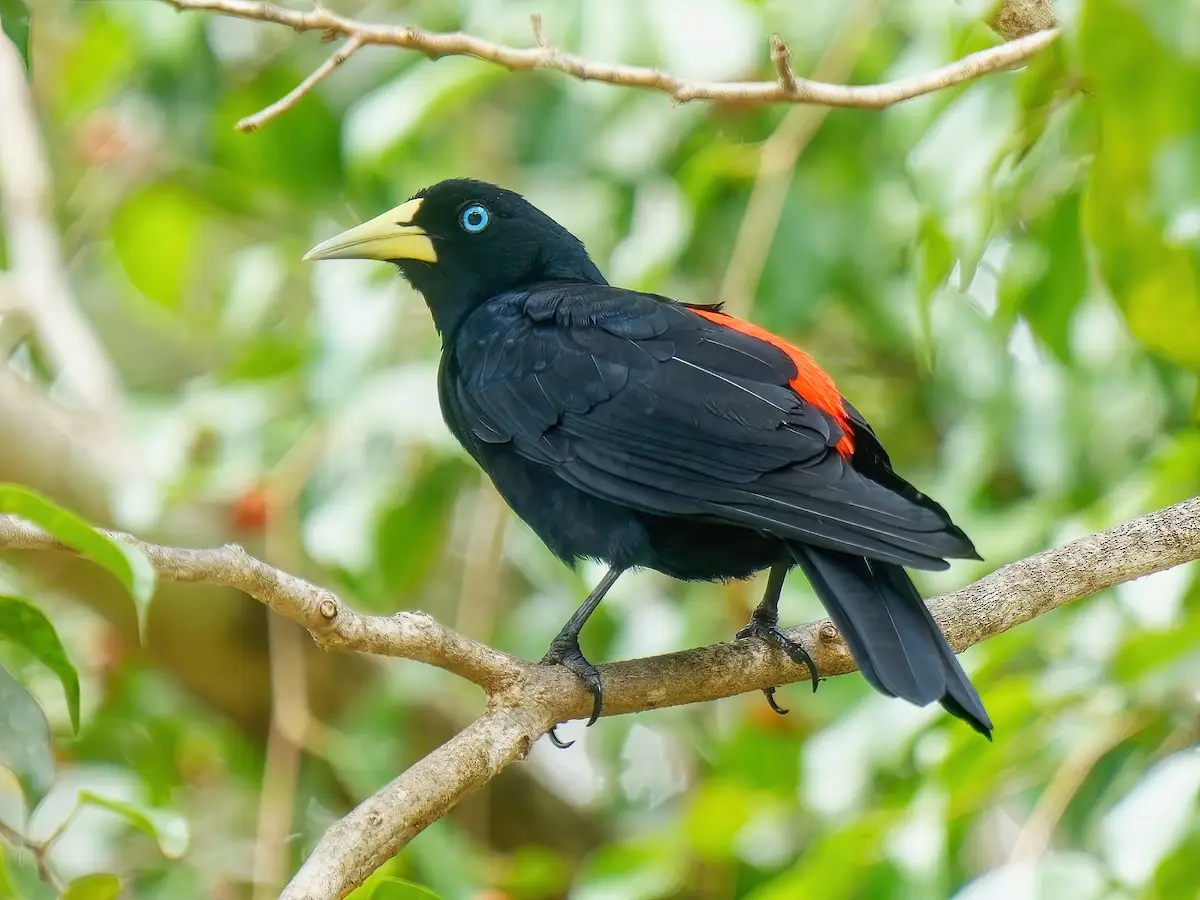
14. Hummingbird
Peru is home to more than 120 species of hummingbirds that inhabit various areas of the country. These tiny, vibrant birds can be found in the Amazon region, the Andes Mountains, and even in the highlands of the páramos. But in the Peruvian jungle, it is much rarer to see one sitting still, so perhaps on your next visit you should bring some nectar with you.
15. Amazonian Barn Owl
The Amazonian Barn Owl is a nocturnal bird that inhabits the jungle regions of Madre de Dios and Ucayali in the Peruvian jungle. This species is characterized by its pale plumage and heart-shaped face. It is also part of Amazonian culture, which includes it in mythological tales due to its peculiar appearance and association with death. Despite this, it is a harmless nocturnal creature that you can hear during your nighttime tours.
16. Mountain Guan
The Mountain Guan or Paujil is a species of bird endemic to the mountainous areas of the Amazon region, especially in the cloud forests of the eastern Andes. This large bird is characterized by its colorful plumage and the crest on its head, which only males have.
17. Spangled Cotinga
This fascinating bird is mainly found in the tropical rainforests of northeastern Peru, particularly in Madre de Dios. Its bright and colorful plumage, with shades ranging from green to blue and yellow, makes it one of the most striking birds in the region. The spangled cotinga feeds mainly on fruits and small insects, and its beauty has made it a favorite among birdwatchers.
18. Potoo Bird
The potoo is a nocturnal bird that inhabits the tropical rainforests of Madre de Dios and other areas of the Amazon region. This bird has a peculiar appearance, with large eyes and brown plumage that allows it to blend in perfectly with the trees. It is known for its melancholic song that echoes through the night.
19. Cock-of-the-rock
The cock-of-the-rock is Peru’s national bird and is found mainly in the regions of Madre de Dios and the cloud forests of the Andes. Its bright red plumage and distinctive crest make it easily recognizable. The cock-of-the-rock is famous for its courtship ritual, where males perform dances to the rhythm of sounds and jumps. We hope you get to see one with your own eyes someday!
Amazon rainforest reptiles and amphibians
If you’re a reptile and amphibian lover, the Peruvian Amazon rainforest is the ideal destination to see these ancient creatures in their natural state. The animals in the Peruvian Amazon include an incredible variety of reptiles, from the most feared snakes like the green anaconda to the fascinating poison dart frogs, known for their bright colors and venomous nature. Prepare to enter a world of the dinosaurs’ ancestors right in the Amazon rainforest.
20. Green Anaconda
Have you heard of the movie “Anaconda”? Well, this one isn’t exactly like that. The Peruvian green anaconda is the largest snake in the world in terms of weight and length. It primarily lives in the swampy regions of the Peruvian Amazon rainforest, especially in the Madre de Dios and Ucayali rivers. Despite its impressive size, the anaconda is not venomous, nor is it a threat to humans, much less during your trip through the jungle, so if you see one, take your camera!
21. Black Caiman
The black caiman can be terrifying at first sight, especially if you see an adult. It is found in rivers, lagoons, and swamps of the Peruvian Amazon region, especially in areas like Madre de Dios and Ucayali. This caiman, which can measure up to 5 meters in length, is a formidable predator, known for its strength and its ability to hunt in the calm waters of the jungle. Although they are impressive animals, black caimans are generally harmless to humans unless provoked.
22. Charapa Turtle
The charapa turtle is one of the most popular turtle species in the Peruvian Amazon. This freshwater turtle lives primarily in the rivers of northern Peru and is famous for its large size and light brown shell. It is often confused with the taricaya turtle, but the charapa is larger and has a broader shell. If you travel at the right time, you can see the annual migrations to the sandy beaches to lay their eggs.
23. Dart frog
The dart frog, also known as the Dendrobatidae, is famous for its bright colors and potent venom, which serves as a defense mechanism against predators. However, the venom of dart frogs in the wild is not fatal to humans, although it can cause skin irritation and discomfort upon contact. Although they are rare, try not to touch them with bare hands.
24. Amazonian Chameleon
The Amazonian chameleon is a lesser-known species in the region, but equally fascinating. This chameleon inhabits the rainforests of Madre de Dios and its surrounding areas and is famous for its ability to change color, adapting to its environment. This ability allows it to camouflage itself perfectly among leaves and branches, helping it escape predators.
You might be interested: Ecotourism in Amazon Rainforest of Peru
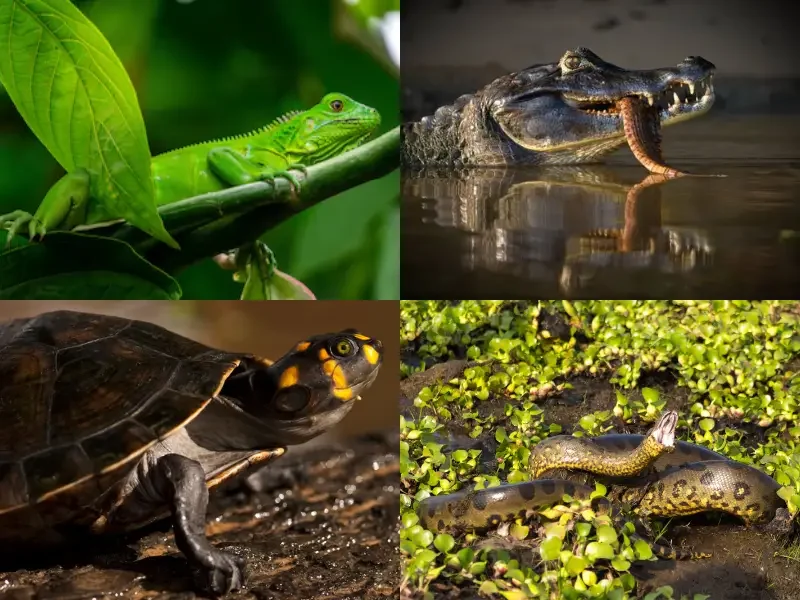
Amazon rainforest insects
In the Peruvian rainforest, you’ll find both harmless and dangerous insects. In fact, there are more insects in the world than people, which makes this ecosystem even more amazing. The Amazon is home to an enormous number of species, many of which have yet to be discovered. Perhaps on your next trip, you’ll discover one. And we can’t forget that the animals in the Peruvian Amazon range from giant ants to brightly colored butterflies. In this section, we delve into the tiny world of Amazonian insects.
25. Leaf-cutter ant
Leaf-cutter ants are small but powerful, and an essential part of the Amazonian ecosystem, where they create impressive “underground gardens” of fungi that they cultivate with the leaves they cut. These ants work in huge colonies and can carry leaves much larger than their own size. You can see them crawling through trees or crossing paths with leaves in their mandibles.
26. Blue Morpho butterfly
The Blue Morpho butterfly is one of the most beautiful species of the Peruvian Amazon rainforest. Its bright blue iridescent wings reflect the light. Their beauty makes them famous in Amazonian ecotourism, where they are considered a symbol of Peru’s natural wealth.
27. Atlas butterfly
The Atlas butterfly (Attacus atlas), one of the largest in the world, can reach a wingspan of up to 25 centimeters. It is found in the Peruvian Amazon, especially in areas of Loreto and Madre de Dios, where it hides during the day among dense vegetation. Its wings, with their simulated eye patterns, confuse predators, and although impressive, they are neither poisonous nor dangerous to humans.
28. Red ants
The fire ants of the Peruvian Amazon, known for their aggressiveness and painful sting, inhabit the soil and trunks of forests. Because of their sting, they are used as an initiation ritual for young people. They form massive colonies and fiercely defend their territory, so we don’t recommend picking one up with your bare hands.
29. Black palm weevil
The black palm weevil is a type of beetle whose larval form is locally known as Suri, an Amazonian delicacy. It lives on fallen palm trees and trunks in the Peruvian rainforest, especially in Madre de Dios. Its appearance may be frightening, but it is an important source of protein for local communities and is part of the Amazonian culinary tradition.
30. Jungle bee
Amazonian bees, like the stingless Melipona, are small but vital for pollinating the tropical flora of the Peruvian Amazon. Unlike European bees, many of these species don’t sting, but they produce honey highly prized for its flavor and medicinal properties. Would you like to try them on your next trip?
31. Tarantula
The Amazonian tarantula is one of the largest arachnids in the rainforest. It lives in burrows in the ground. Although its appearance may be intimidating, it is rarely dangerous to humans. It is nocturnal and fascinating for visitors curious about Amazonian wildlife.
You might be interested: Amazon rainforest packing list
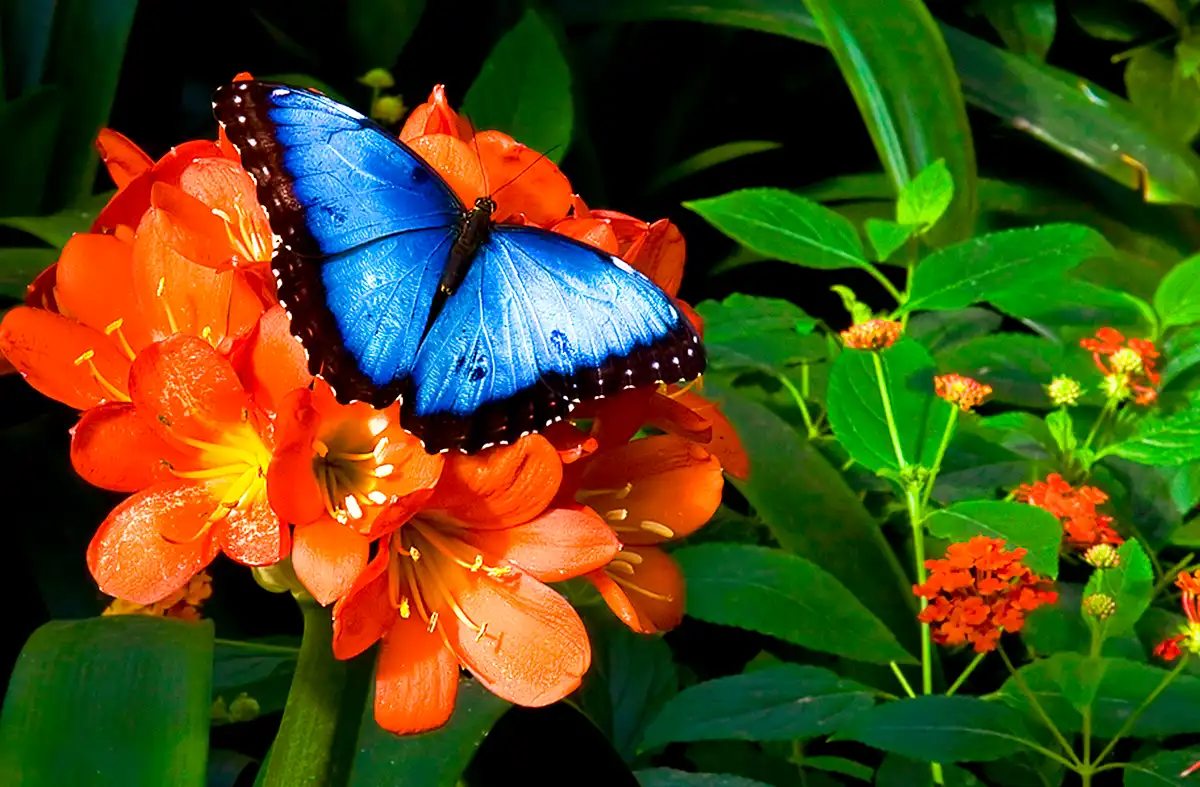
Amazon rainforest fish
Navigating the rivers of the Peruvian Amazon, you’ll notice the life that swims in its waters just by looking to the side of the boat. Amazonian animals swim with hypnotic movements and colors that dazzle even under the murky water. Immerse yourself in this section, where we introduce you to the aquatic world of the animals in the peruvian amazon that inhabit the waters.
32. Arapaima
The arapaima, also known as the Paiche, is one of the largest freshwater fish in the world and lives in the Amazon, Ucayali, and Marañón rivers in Peru. It can grow up to 3 meters long and weigh more than 200 kg—a true aquatic giant! It is also an emblematic fish of sustainable Amazonian fishing and a symbol of the region’s biodiversity.
33. Red piranha
The red-legged piranha is famous for its reputation as a “fearsome predator,” but in reality, its attacks on humans are rare. It lives in schools in the Amazon and Madre de Dios rivers, protecting its young. It feeds on fish, insects, and fruit that fall into the water, and its sharp teeth are perfect for slicing into small prey. You can participate in the famous piranha fishing tours in Tambopata.
34. Pirarucu
The pirarucu, sometimes confused in Peru with the arapaima, is a peaceful giant of the Amazon, found in the rivers of Loreto and Ucayali. It can reach more than 2 meters in length and is known for its scaly, almost armor-like skin.
35. Tambaqui
The tambaqui is a rounded, strong fish that lives in the Amazon Rivers and its tributaries in Peru. It is famous for its voracious appetite for fallen fruit and seeds, helping to disperse them and maintain the health of the aquatic ecosystem. It can weigh up to 30 kg and is highly prized in local cuisine. Perhaps on your next trip, you can try the freshly caught catch of the day!
36. Pacu
The pacu is an Amazonian fish related to the piranha, but much more peaceful and vegetarian. Found in rivers in Madre de Dios and Loreto, it is recognized by its square-shaped jaw and human-like teeth, perfect for crushing fruits and seeds. So it’s safe to swim alongside it in the waters.
You might be interested: Amazon Jungle Mysteries

Exotic animals in the peruvian amazon
The Peruvian Amazon is like a living treasure chest, full of amazing trees, rivers, and shadows that hide all sorts of cool creatures. There, tiny, shiny critters like the Glass Frog or the Ghostly Poison Dart Frog hang out, and then there are the big, quiet ones like the Green Anaconda or the Black Caiman that scurry around the jungle. Every time you learn about something new, it’s like discovering how cool nature is, right? In this part, we’ll look at the most unusual and hard-to-find creatures in the Peruvian Amazon, the ones you don’t see every day and that turn the jungle into a place full of secrets and wonder.
37. Yellow-tailed woolly monkey
The yellow-tailed woolly monkey is an endemic and extremely rare primate native to the highland rainforests and cloud forests of Cusco and Madre de Dios. This monkey is known for its long, dark brown fur and distinctive yellow tail, which makes it unmistakable. It lives in small family groups and moves nimbly through the treetops, feeding on fruit and leaves.
38. Andean bear
The Andean bear is the only bear native to South America and primarily inhabits the montane forests of Cusco, Apurímac, and San Martín, although it is difficult to see and is protected in specific conservation areas. This omnivorous mammal is known for its dark fur and the characteristic “light-colored arc” on its chest, which makes it very photogenic for those lucky enough to see it.
39. Paca
The paca is a robust, nocturnal rodent found in the Peruvian Amazon. It is known for its mottled fur and large eyes, which allow it to move nimbly in the dark. Its diet consists mainly of fruits and seeds. We hope you can see this tender rodent on your trip to the Amazon.
40. Glass frog
The glass frog is a small treasure of the Peruvian Amazon. Can you guess its uniqueness? Its skin is almost completely transparent on the abdomen, allowing you to see its internal organs, as if it had a built-in microscope. These tiny creatures, barely 3 to 5 cm long, usually live on tall leaves near water and emit soft croaks at night.
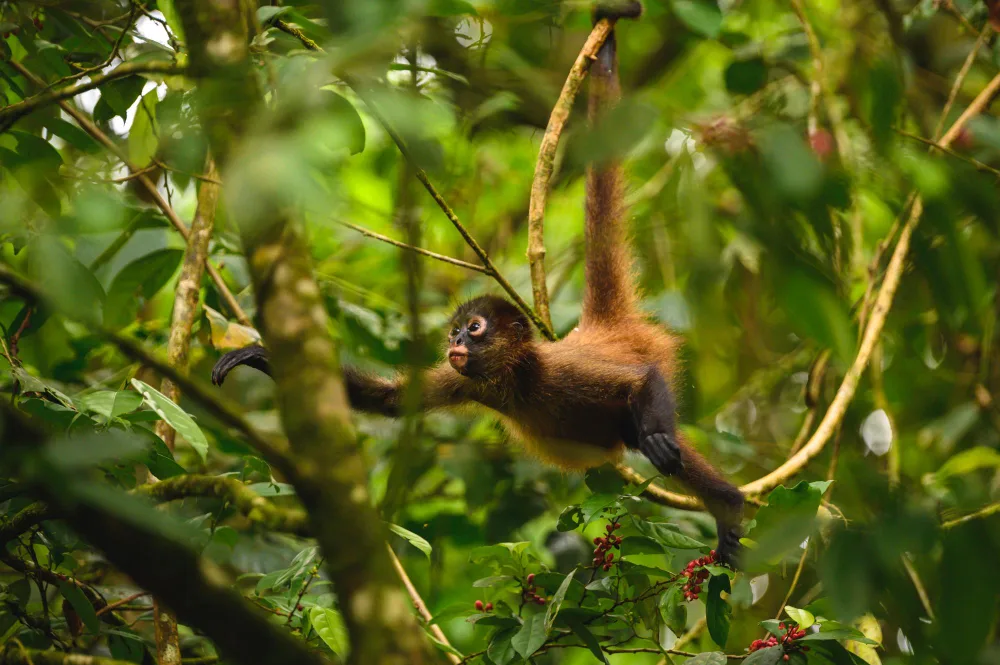
Recommendations for encountering animals in the peruvian amazon
We hope you get to see some cool exotic animals on your next trip to the Peruvian Amazon, like Jaguars, Pink Dolphins, Giant Otters and Macaides, and maybe even some new ones we haven’t discovered yet. But hey, gotta do it right and smart, you know? When you’re up close with wildlife, it’s pretty important to know how to handle everything without messing up the environment or hurting the animals themselves.
In this part, we’re going to drop some tips on how to get the most out of animal chats, like how to spot birds and hang out with them directly. Just remember, we have to treat animals differently, respect them, and keep it ethical when we’re watching them.
Choose the right place and guide
Pick recognized reserves and work with certified local guides who understand animal behavior and conservation practices. This ensures you’ll have better chances of spotting wildlife while minimizing your impact on the environment.
Understand the seasons
The Amazon has two main seasons: high water (December to May) and low water (June to November). During high water, you can access flooded forests by boat, while low water makes it easier to explore on foot and often brings animals closer to the riverbanks and lagoons. Both seasons offer unique wildlife experiences.
Respect wildlife ethics
Keep a safe distance, avoid sudden movements, and never attempt to touch or feed the animals. Flash photography, loud noises, or chasing wildlife can disrupt their natural behaviors. Silence and patience are often rewarded with the most authentic sightings.
Experience based on habitat
Macaws and parrots gather in spectacular numbers at clay licks, where observers should remain quiet and hidden. Riverbanks and oxbow lakes are great spots to see caimans, giant otters, and waterfowl. The canopy, accessible via observation towers or guided walks, reveals monkeys, sloths, and a wide variety of birds.
Traveler health and safety
Vaccines like yellow fever, preventive measures against mosquito-borne illnesses, and the use of repellents and protective clothing are essential. Boots, rain gear, and flashlights will help you handle the challenges of the rainforest terrain.
Follow local laws and customs
It’s strictly prohibited to remove wildlife, collect feathers or skins, or buy animals. Respect community norms, conservation rules, and park regulations—they’re in place to protect both visitors and the delicate balance of the rainforest.
You might be interested: Vaccines for the Amazon Rainforest: What’s Essential for a Trip?
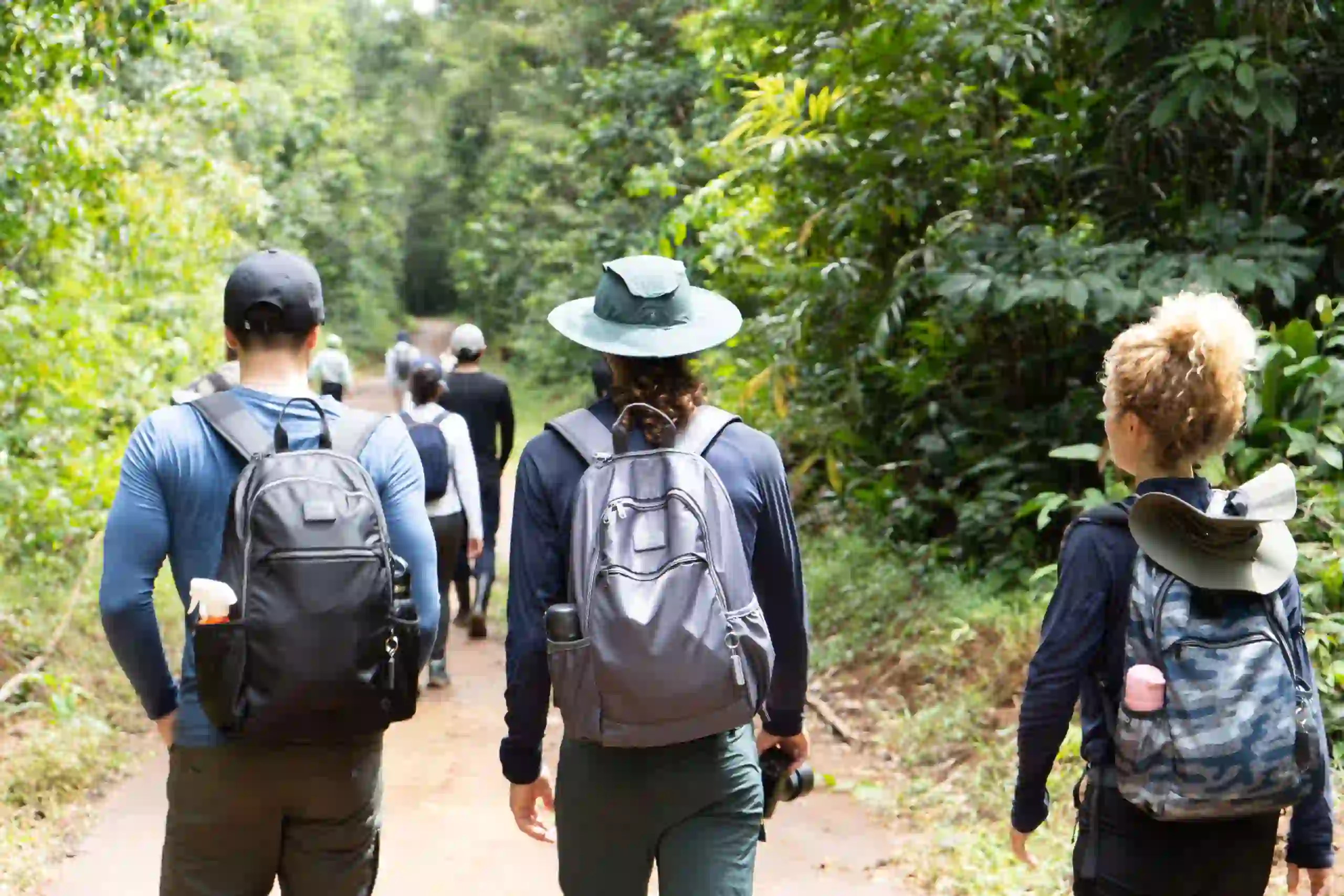
What to pack to see animals in the Peruvian Amazon
Now that you know the different animals, choose your favorite and challenge yourself to see them in their natural habitat on your next trip. Here’s a list of everything you need to consider for your next encounter with the animals of the Peruvian amazon.
- If you want to see the animals, bring Light binoculars (8x–10x) especially for spotting birds, monkeys, and other animals without getting too close.
- Camera with telephoto lens so you can capture animals without disturbing them with sound and remember not to use flashes.
- Use Long-sleeve shirt and lightweight pants to protect against mosquitoes, sun, and scratches from vegetation.
- Rubber or trekking boots are a must for walking on wet, muddy, or root-filled terrain.
- The best thing against rain is Raincoat or poncho because in jungle rain can surprise you at any time.
- Hat or cap and sunglasses are useful for river trips under intense sunlight.
- Insect repellent and sunscreen especially for skin protection in a tropical environment.
- Headlamp with extra batteries: needed for night walks or inside lodges.
- Notebook or note-taking app are perfect for recording observed species, behaviors, and experiences.
- Lightweight, waterproof backpack to carry everything comfortably and keep it dry.



